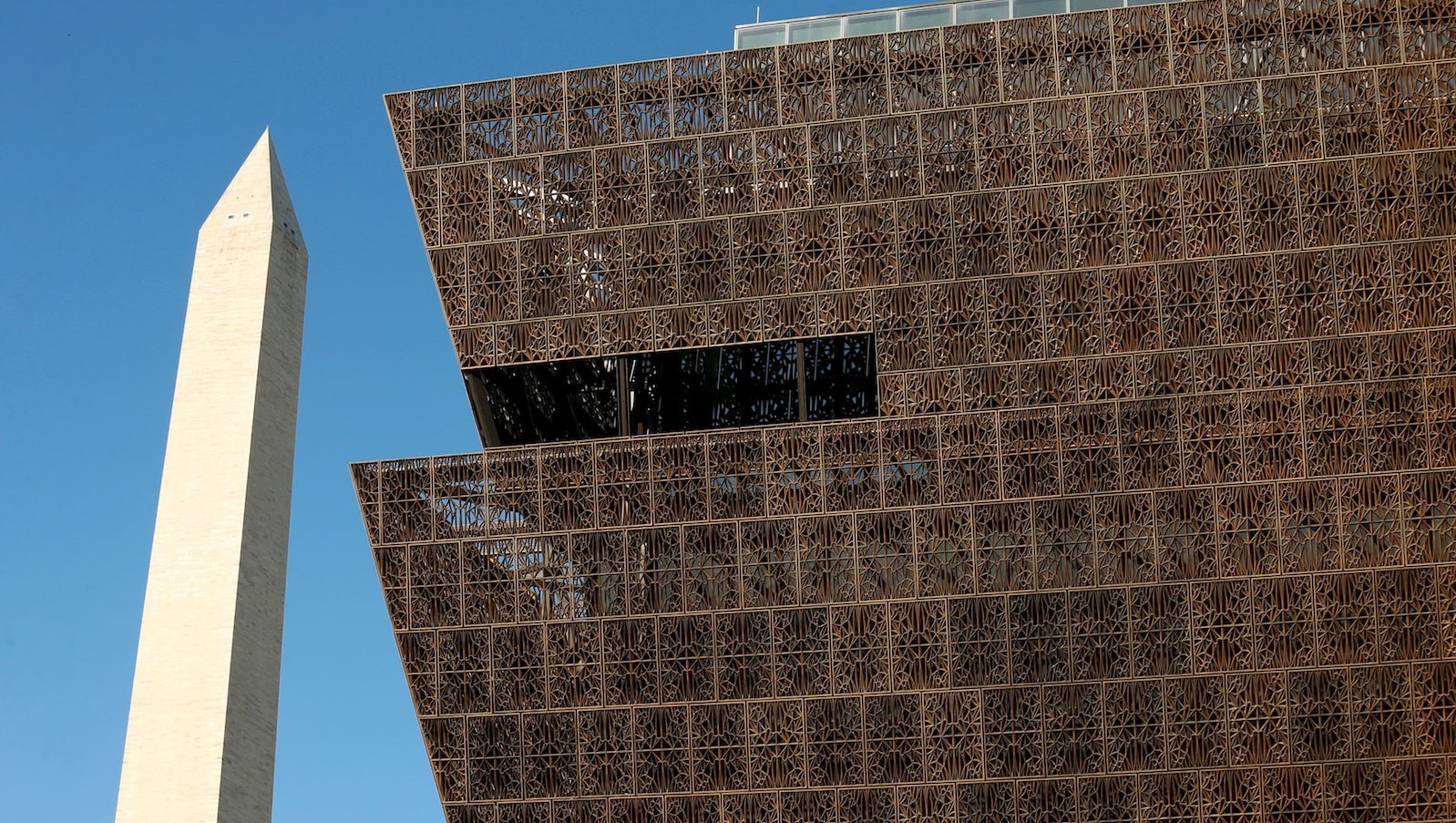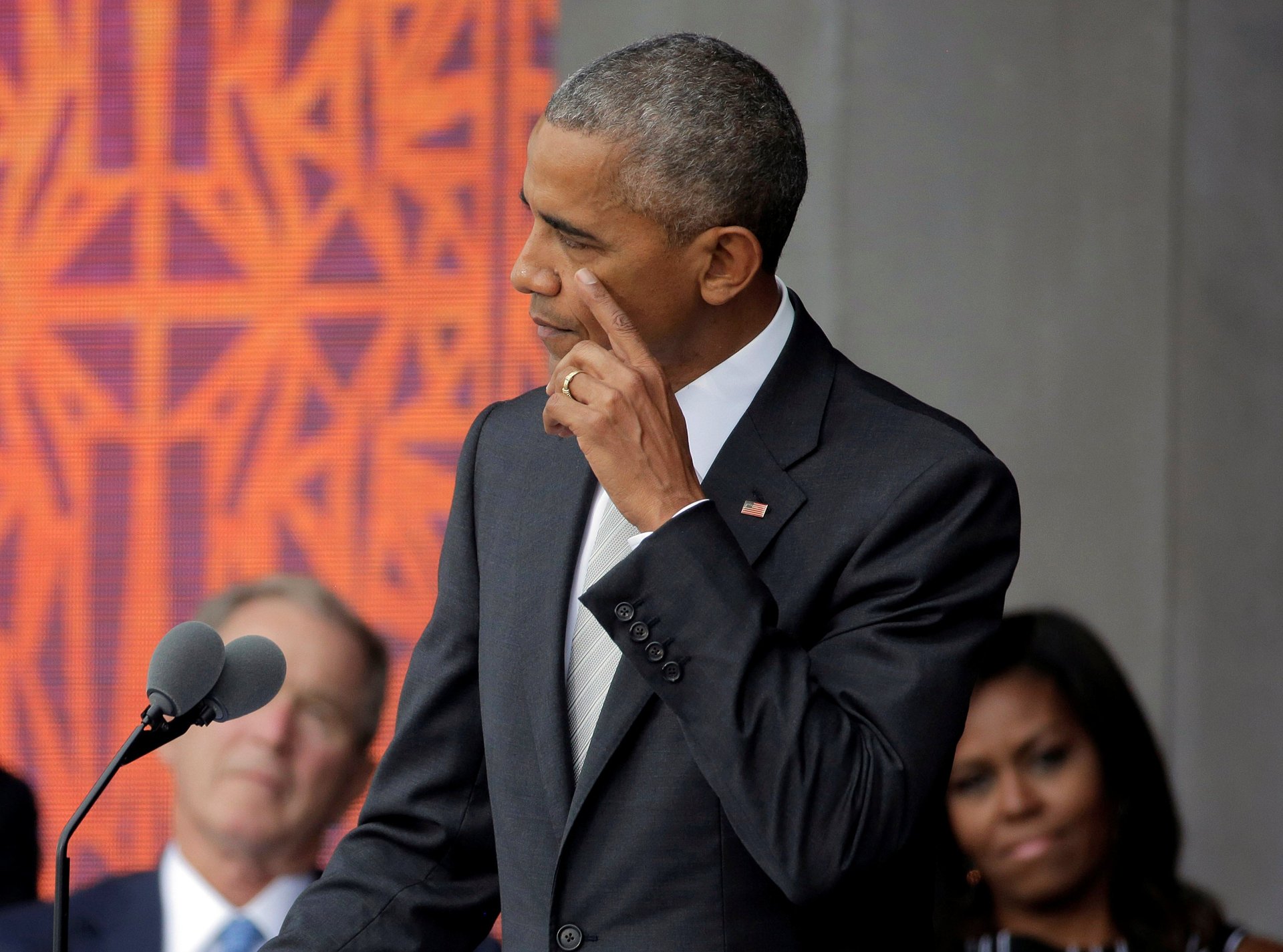Inside the African-American history museum on the last day of Obama’s presidency
Washington, DC


Washington, DC
On the last day the US had a black president, Annie-Laura Howard Stephens slowly but surely pushed herself around the National Museum of African American History and Culture.
In her wheelchair, Stephens made her way through the museum’s lowest level, dedicated to the roots of slavery, past the chains that bound the Africans forcibly brought to the US by ship in the 1600s, past the statue of Thomas Jefferson (who helped formulate the declaration that “all men are created equal” while owning 609 slaves over the course of his life), and past Frederick Douglass’s cane, carved with scenes from his remarkable life.
“I feel a connection to the past generations,” Stephens said, “and the spirit that has carried us.” She wore a red hat and a matching red scarf, with her own cane resting on one shoulder. She’s 72, originally from Savannah, Georgia. When she was born, the American south was in the full-throated grip of Jim Crow: public places like restaurants and trains stations were segregated into whites- and coloreds-only; anti-miscegenation laws barred interracial marriages; lynching was common. She was 11 when Emmett Till was murdered, sparking the outcry that lit what would become the civil rights movement, 20 when the Civil Rights Act was passed, and 64 when Barack Obama was elected US president.
But when asked if it was bittersweet that today—Jan. 19, 2017—was the last day of Obama’s presidency, she was confused. “It’s a day for rejoicing, it’s a day of blessings,” she said. “To come from where we came from and for a black man to be president of these United States, it lets me know that God’s word is true.” Stephens was here with a social justice group from Atlanta. They were not here for the inauguration of Donald Trump on Jan. 20, but to protest in the Women’s March taking place the following day.
Plans for a “national negro memorial” have existed since the early 1900s, at first to honor black troops who fought in the Revolutionary and Civil Wars, but culminating in plans for a full-fledged Smithsonian museum signed into existence by then-president George W. Bush in 2001 and opened by Obama in 2016. Many chose to spend this last day before everything changed here. The museum was busy from the minute it opened to when it closed.
It was full of all kinds of people, not just the many, many black families who came, but school groups and interracial couples and circles of older women. They stayed for hours, looking at every object in the building. There was a disabled girl with “Thank you, Obamas” on the back of her wheelchair and a young mixed-race girl whose T-shirt read, “I met God she’s black.”

Many seemed to struggle with their emotions. It was not just that there might never be another black president, but also that there might never be a president of any kind as good and decent as this one, with his endless collection of beautiful speeches, his jokes, his beautiful family, and his class and dignity in the face of years of constant attacks to delegitimize his Americanness—many by his successor.
It’s impossible to compress the sweep of history into one place. Of his Emancipation Proclamation freeing the slaves, Lincoln said “if my name ever goes into history it will be for this act, and my whole soul is in it.” (Lincoln even fretted about his signature: “If my hand trembles when I signed the proclamation, all those who examine the document hereafter will say, ‘He hesitated.’”) At the museum, the Proclamation is presented as a faded, barely readable facsimile of the original. But the museum also finds hidden gems, unearthed and given new life. A copy of Douglass’s newspaper The North Star, established in 1847, whose motto still sounds radical today: “Right is of no sex—truth is of no color.”
Many of the women visiting wore anti-Trump badges as they walked around, looking at showpieces like a segregated train carriage from the 1950s. Chartisia Griffin, who was part of the same group from Atlanta as Stephens, was in floods of tears after hearing a recording about slave children on plantations split from their parents who tried to sneak in at night to be with them. “I feel like we’re taking a step backward,” said one woman visiting from Oregon. “I was hoping to come for Hillary’s inauguration. I don’t know how we’ll survive the next four years.” In front of a section on lynchings, three white women hugged each other in silence.
One teacher, a big, bald man in a white turtleneck, was trying to convey to a group of fidgeting black schoolchildren who couldn’t have been older than eight or nine, just what being a slave was like and how much money was made off their backs. “That means at 5am, you had to get up and spend all day in the fields,” he told them. “Say you guys were slaves and I was your owner. This”—he pointed at numbers in a nearby display—“is how much you were making in cotton. And this is how much I was making of you. It’s not like 2017 where basketball players are making millions of dollars. This is in 1861.” Those children have never known anything other than a black president.
And there were Trump supporters, too.
One of them, a huge bear of a man named Matt Weaver, was moved by what he saw. “Growing up white, I had heard of slavery and all that, but I didn’t know all of the history,” he said. “It makes you sad, that these people had to go through this pain and suffering.” He said the museum was helping him to understand why Trump worried so many people. “It gives you some insight into the way he comes across to people of other nationalities.”
Near the display bearing the life story of John Lewis, the civil rights hero and current congressman insulted and dismissed by Trump only a few days earlier, a flock of young, white boys were racing around in their red “Make American Great Again” hats. ” They were there for Trump’s inauguration the following day.
“I’ve been so sick and tired of seeing these are all-talk, no-action politicians for years do nothing,” said Connor, 15, with braces and browline glasses, echoing the language (“all talk, talk, talk—no action or results”) Trump used against Lewis. “And when Obama was elected, everyone thought that the inner cities would be fixed and race relations would be fixed but they’ve actually gotten worse because he’s just talked a whole bunch and done nothing.”
“I was excited when he was elected,” he continued. “I mean, the first black president. Who doesn’t love that? I skipped school both of his inaugurations. But he never acted upon his words.” He and his friends, from Salt Lake City, Utah, were not worried in the same way that many people walking around them were about what the transition to Trump meant for minorities. “He’s already brought jobs back, and that’s what minorities want,” said Zack, also 16.
They were loving the museum; Connor was interested to find out that the banjo was first created by slaves. Another in their group, David, 15, was surprised to find out how far back the role of black soldiers went. “It was kinda cool to find out that they’ve been in the military and had their own regiments since the Revolutionary War. I mean, the first guy to die in the Revolutionary War, in the Boston massacre, was a black guy,” he exclaimed, referring to the life of Crispin Attucks. “The first guy to shed blood for our country was a black guy!” he said, and they all nodded.
All were happy to have come of age in the Obama era. “I think growing up with a black president is showing that the nation is getting a little bit better with race,” Connor said. “It really shows truly anyone can be president of the United States, the most powerful person in the world, even some crazy-haired billionaire or some black guy from Chicago.”
But of course, historically it’s been much easier for one of those than the other. Only one small display at the very end is devoted to Obama; the museum seems less sure of how to portray the symbolism and power of his election than it is about anything else.
Part of that is the uniqueness of Obama. Born to a Kenyan father and a white American mother, and raised by a white family that loved and embraced him in the era after civil rights, Obama’s personal history doesn’t bear many of the scars of the violence and horror of what is in this museum. “That danger is not part of Obama’s story,” as Ta-Nehisi Coates has noted.
In fact, many civil rights leaders featured in the museum backed Hillary Clinton over Obama when he first ran for president. When the nation was finally ready to elect a black president, most didn’t see it coming. “Being African-American, sure, my heart was with him,” James Clyburn, a civil rights hero and current congressman, told Matt Bai of the New York Times (paywall) in 2008. “But I’ve got a head, too.” At the time, Lewis told Clyburn that after all these years of struggle, history was about to happen. “And I’m on the wrong side,” he said. (Lewis would later switch from backing Clinton to backing Obama and say (paywall), “Barack Obama is what comes at the end of that bridge in Selma.”)
The museum’s caution in portraying Obama might also be due to a wariness of suggesting a happy ending. Racial tension across the US preceded the opening of the museum—from the police brutality that set off the Black Lives Matter movement to the massacre of nine people by a white supremacist at a historically black church in Charleston, South Carolina—and echoed the tragedies of the civil-rights era. And yet there is no other way to end the story of the museum at this point in time than with the election of the country’s first black president.
The final still image you see before you walk out is a photo of millions watching Obama’s first inauguration, his hand on Lincoln’s bible, almost eight years ago to the day. Before they left, many gathered by the photo and tried to spot themselves in the crowd, or reminisced about the moment Obama took office eight years, or chatted about their fears for the next four years.
At one point during the day, the lights went out due to a power outage. We were quickly shuffled out of the galleries to the exit, past the displays on the “economics of lynching” and the Tuskegee fighter plane and civil rights and the Black Power movement and Obama. We were out in the daylight, temporarily blinded. I joked to the person next to me that it felt like a metaphor. “Let’s hope not,” she replied sharply.
Outside, a black woman sold “We’ll miss you, Obamas” bags and shoes next to a white man selling Trump merchandise.